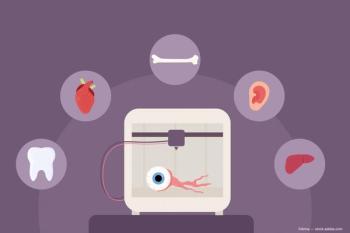
Knowledge is key for successful DALK procedure
Understanding corneal anatomy can minimize risk of Descemet’s membrane rupture
Knowledge of the presence and characteristics of the pre-Descemet’s layer provides a foundation for the understanding of tissue separation during deep anterior lamellar keratoplasty that will minimize the risk of rupture with Big Bubble creation and during the remainder of the procedure.
Reviewed by Sadeer B. Hannush, MD
Knowledge of corneal ultrastructural anatomy that recognizes the presence of the pre-Descemet’s layer (PDL) brings a new understanding to deep anterior lamellar keratoplasty (DALK) and its successful completion, said
Dr. Hannush, attending surgeon, cornea service,
Whether or not the PDL is left behind with the DM and endothelium after air injection to create the
“A BB type 1 (BB1) cleaves off or separates the posterior stroma from the PDL, leaving the PDL behind with DM and endothelium. In this scenario, there is little risk of perforation into the anterior chamber because the PDL has such a high bursting pressure,” he said. Dr. Hannush also noted that a Big Bubble type 2 (BB2) forms between PDL and DM, leaving behind DM and endothelium.
“In this situation, the risk of rupture into the anterior chamber is greater because the bursting pressure of DM is only around 30 mm Hg, and this risk remains increased during the remainder of the procedure due to the fragility of DM,” he explained.
Dr. Hannush said that by allowing surgeons to identify the location of the cannula before injecting air to create the BB, intraoperative OCT is helpful for achieving a BB1. Surgeons who do not have access to this imaging tool may be able to judge whether a BB1 or BB2 was created based on how it is formed.
RELATED:
Dr. Hannush noted that surgeons need to recognize that they are dealing with a more tenuous situation that requires patience and attention to detail in order to bring DALK to a successful completion.
Dr. Hannush offered several pearls for proceeding in the setting of a BB2.
“Ideally, the viscoelastic device cannula may be replaced with the same cannula used to create the BB (eg.,
Dr. Hannush also advised use of rounded scissors to remove the posterior stroma/PDL after creation of BB2 and cautioned against “leaning” on DM with the posterior blade of the scissors. The Tan DALK scissors, which features a platform on the posterior blade, is designed specifically for this maneuver in cases of both BB1 and BB2.
“Before proceeding, however, ensure that the big bubble (1 or 2) extends to or beyond the trephination mark and that there are no adhesions between PDL and DM,” Dr. Hannush concluded. “They can lead to rupture during removal of the posterior stroma (BB1) or the posterior stroma/PDL (BB2).”
RELATED: These 3 things are part of a cataract surgeon's signature
Disclosures:
Sadeer B. Hannush, MD
E: [email protected]
This article was adapted from Dr. Hannush’s presentation during Cornea Day at the 2019 meeting of the American Society of Cataract and Refractive Surgery. Dr. Hannush has no relevant financial interests to disclose.
References:
1. Dua HS, et al. Ophthalmology. 2013;120:1778-1785.
Newsletter
Don’t miss out—get Ophthalmology Times updates on the latest clinical advancements and expert interviews, straight to your inbox.
















































.png)


